|
The
Two-Phase Barbell
Shoulder Press
If you've ever had a hard time developing your shoulders,
this exercise is going to be a lifesaver for you! Personally,
shoulders are one of my WORST bodyparts. It's tough to
keep them strong...tough to get them bigger...and tough
to really feel them working when I'm actually doing shoulder
exercises!
But the first
time I used this technique, it absolutely blew my mind.
As soon as I finished the set, my shoulders felt like
they were inflating! The blood was came rushing in and
I knew I was on to something special...that RARELY happens
to me with ANY shoulder exercises.
So what makes
THIS exercise so special? You're going to reach muscular
failure TWICE within the same set. AND you're going to
do it with NO REST in between the two phases of the exercise.
BAM BAM...one part right into the next.
But here's
the twist...it's not a typical drop set in which you reduce
the weight to achieve this! You're going to use the SAME
weight for both phases of the exercise.
The REAL key
lies in the range of motion of each part of the exercise...
You see, when
you do a normal barbell shoulder press, as you push the
barbell up, you go through what is called a strength curve.
In basic terms, it means at the bottom of the movement
you are fairly strong. But as you press further (normally
about 3 to 5 inches up in the movement) you hit a point
where the leverage in your shoulders changes. The exercise
gets a lot tougher.
This is called
a sticking point - it's basically the weakest point in
the exercise. Another example of a sticking point is commonly
seen in the bench press. If you were doing a bench press
using a heavy weight, lowered the weight to your chest
then started to press but couldn't get past a certain
point (a few inches above your chest), THAT is also a
sticking point.
Bottom line,
you can only lift as much weight as you can move through
that WEAKEST point in the range of motion of an exercise.
But OUTSIDE that sticking point, your muscles are stronger
and can lift more weight!
The question
becomes, how do we still do full range-of-motion lifting
while putting greater tension on the muscles to maximize
their strength in OTHER phases of the movement?
We're going
to break the movement into two distinct phases. On the
first phase, you're going to do FULL reps of the shoulder
press. When you can't do any more full reps, you're going
to do partial reps in ONLY the top, stronger half of the
range of motion.
It's a powerful
technique and it'll get your shoulders burning like crazy!
The key to
geting the most out of this exercise is the setup...
How to Do the Two Phase Shoulder Press:
First, you'll
be doing this exercise in the power rack. While there
IS a way to do it without being the rack (and it is still
effective that way), the rack is going to allow you to
really push your shoulders to the maximum.
Set the safety
rails in the rack to just below shoulder height. You're
going to be doing a standing military barbell press for
your shoulders, bringing to the front, of course! I NEVER
recommend doing any behind-the-head shoulder pressing
- it can cause shoulder damage.
For this exercise,
start with a weight you can get at least 8 to 10 reps
for. I would suggest doing 3 or 4 sets of this exercise
in total for your shoulder workout.
Grip the bar
with your pinkies or fourth fingers on the smooth rings
of the Olympic bar. You need to take a narrower grip on
the bar than with the bench press. The rails should be
set so you have to bend your knees a bit to get under
the bar. The bar should be held across your extreme upper
chest.
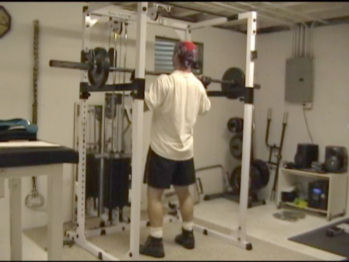 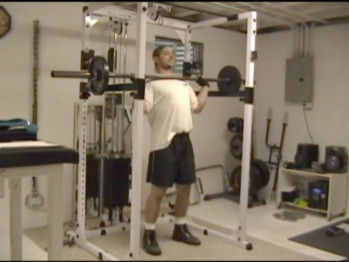
Next, begin the pressing movement. Press the barbell up
in front of your face then lockout at the top. When you
do a military press, your knees should be slightly bent
and abs tight to keep stress off the lower back.
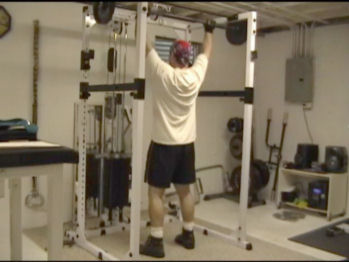 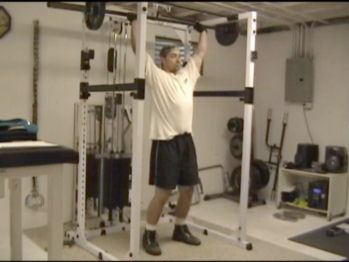
Because of
the path of the bar, you will be leaning back a little
bit - it has to go in front of your face. But as soon
as the bar clears your head, shift your torso forward
so that the bar is DIRECTLY over your head. It almost
resembles a bobbing-forward motion. This is a key point
that a lot of people miss with the shoulder press. If
you keep leaning back, it keep tension on the front delts
and takes it off the rear delts.
Lower the weight
slowly back to your chest then press again. Keep going
until you can't get the weight past the sticking point.
Try and get it past the sticking point, though! We want
to be sure you're right at the limit.
When you're
done, set the bar back on the safety rails. And here's
the trick that's going to set your shoulders on fire...keeping
your hands locked onto the bar, drop down onto your knees
under the bar. Now keep pressing in the partial top range
of motion of the press!
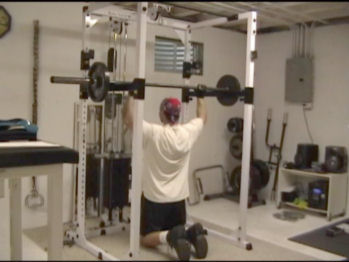 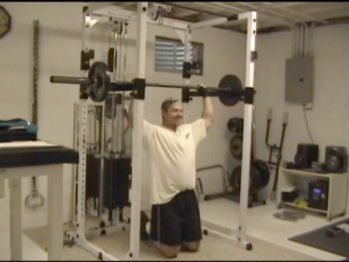
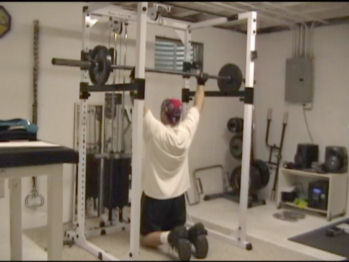 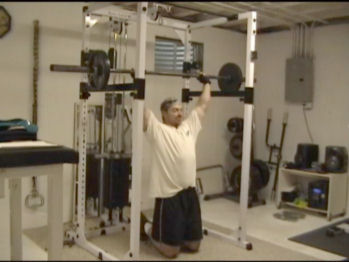
Because the bar is now ABOVE the sticking point, your
shoulders have better leverage and can continue with the
exercise! Do as many reps as you can until you can't even
budge the bar. I prefer to set the weight down on the
rails in between reps here but you can keep a continuous
movement, if you want. Do it whichever way feels best
to you.
By exploiting
the top range of motion after fatiguing the muscles in
the full range of motion, you're going to finally be working
the shoulders with FULL resistance in the whole range
of motion.
When you're
done, stand up. Your shoulders will be swelling up any
second now!
As I mentioned
previously, there IS a way to perform this technique without
a power rack.
First, perform
the barbell shoulder press, just like above. Now, instead
of doing reps until you can't get past the sticking point,
you're going to have to stop a rep or two SHORT of that
point of failure.
Basically,
you're going to have to complete that last rep to the
TOP. When you're at the top, now lower the bar only halfway
down (just above where your sticking point normally is)
then press it back up to the top.
Keep doing
reps in this shortened range of motion until you can't
hold the bar up anymore!
Conclusion:
Give this exercise
a try in your next shoulder workout. If you've got good
shoulders, this will blow them up even more. If you've
got poor shoulders, you're going to be in for a treat!
|